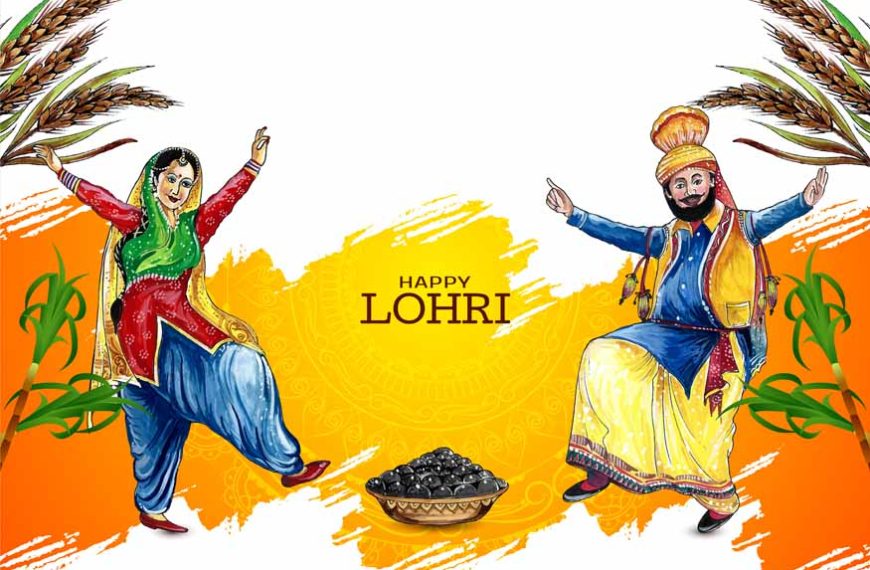As the New Year begins, preparations for harvest festivals across India also start in full swing. In Punjab, families gear up for Lohri, while in Tamil Nadu, the preparations for Pongal are underway. Meanwhile, in Maharashtra and Gujarat, families prepare for Makar Sankranti and Uttarayan. For parents, these harvest festivals are a wonderful opportunity to share rich cultural traditions with children, engage in fun outdoor activities, and teach them about the significance of nature, agriculture, and community.
If you celebrate Lohri or are curious about the festival, you are in the right place. In this article, we will explore everything you need to know about the Lohri festival, from its rich history to its cultural significance.
When is Lohri Celebrated This Year?
This year, Lohri will be celebrated on January 13. Every year, during the month of Paush, Lohri marks the beginning of the harvest season for rabi or winter crops with much fanfare, especially by the people of Punjab. Originally, Lohri was celebrated on the night before the winter solstice, but more recently, it is celebrated the day before Makar Sankranti.History of Lohri
There are numerous stories about why we celebrate Lohri, but what is indisputable is that it is the celebration of the winter solstice. Everywhere in the world, the winter solstice is marked by the lighting of a bonfire, which marks the return of longer days.
The origin of Lohri in India can be traced back to the legend of Dulla Bhatti, who lived in Punjab during the 16th century during the reign of Akbar. He is hailed as a hero of Punjab as he saved destitute Punjabi girls, Sundari and Mundari, from being sold in the slave marketplace of the Middle East. He is believed to have been a dacoit and a brave warrior who used to rob the rich and help the poor with money and food, making him very popular in Punjab. The Lohri festival is supposed to commemorate Dulha Bhatti’s valour against the tyranny of the Mughal rulers. During Lohri, bonfires are lit, sweets are exchanged, and traditional Punjabi folk songs and dances are performed to Dulha Bhatti.
Some people believe that Lohri derived its name from the word ‘Loi,’ who was the wife of Saint Kabir. Others believe that Lohri derived its name from the word ‘Loh,’ which refers to the warmth and light of a fire. While many others believe the word ‘Loh’ refers to a tawa, which is used to make rotis or chapatis.
Significance of Lohri
Lohri festival holds great significance because it marks the harvest of the rabi crops and the end of the winter. The festival is celebrated to express gratitude to the sun and the fire for the good harvest. It’s safe to say that Lohri is not just about festivities and celebrations; it’s also the celebration of the deep connection of humans, nature, and tradition.
Lohri is also celebrated to commemorate the end of the winter solstice, when the earth is farthest from the sun. It begins its journey towards the sun in the month of Paush, which is the coldest month of the year. It heralds the beginning of Magh and the favourable period of Uttarayan. It brings with it the promise of spring and celebrates the renewal of nature.
It’s a great time for community bonding as families gather, exchange gifts and gather around bonfires to celebrate.
According to the Bhagavad Gita, Lord Krishna revealed himself in his full splendour at this time. Hindus wash away their sins by taking a dip in the holy Ganges river.
Where is Lohri Celebrated?
As mentioned before, Lohri is a harvest festival that’s predominantly celebrated in Punjab and its nearby areas. However, the harvest festival is celebrated in different states under different names.
- In Tamil Nadu, Pongal is celebrated as the harvest festival, lasting for 4 days.
- In Andhra Pradesh, it transforms into Bhogi, a celebration of letting go of the old to welcome the new. In some parts of Andhra Pradesh and Telangana, it is celebrated as Pedda Panduga, which means ‘big festival.’
- In Assam, the spring harvest festival is celebrated as Bihu and is a time for feasting, singing and dancing to celebrate the harvest of the first rice crop.
- In Gujarat, it is celebrated as Uttarayan, the delightful kite festival.
- In Karnataka, the harvest season is celebrated as Suggi Habba.
- In Uttar Pradesh, it is celebrated as Makar Sankranti in some places and Khichdi Parv in others.
- In West Bengal, this harvest festival takes a more spiritual turn and is known as Poush Sankranti.
How to Celebrate Lohri
The Lohri festival is traditionally celebrated by lighting a large bonfire in the yard after the Rabi crops are harvested. Small idols of the Lohri goddess are made using cattle dung and placed beneath the fire. The bonfire is lit at sunset, and people dressed in vibrant traditional attire gather around it. They offer sesame seeds and jaggery to the flames as a symbolic gesture. Families and friends sit around the fire, singing and dancing joyfully until it burns out. This ritual is a way to pray to the Fire God, seeking blessings for abundance and prosperity in the coming year.
Let’s dive deeper into the details of how to celebrate Lohri.
- Bonfire: Huge bonfires are lit in the yards of homes. People gather around the fire and circle it while tossing puffed rice, peanuts, sesame seeds and popcorn into the fire, dance and sing popular folk songs.
- Prasad: Prasad is a traditional offering of sweets or savouries made for the gods. For Lohri both sweets and savouries like til laddoos, gajak, jaggery, popcorn, and peanuts are offered as prasad to the gods and then shared with family and friends.
- Kite Flying: Kite flying is an extremely popular Lohri tradition where people gather on rooftops and fly different colour kites of different shapes and sizes. Kite flying is believed to bring good luck and prosperity.
- Folk Songs and Dances: Lohri is incomplete without traditional folk songs and dances. Traditional songs like ‘Sunder Mundriye,’ ‘Jind Mahi’ and ‘Satti Satrangi’ set the mood for the evening as people dance to them around the bonfire.
- Exchanging Gifts: Gifts like clothes, sweets and money are exchanged with friends and family in Lohri to express love and gratitude.
- Prayers for a Good Harvest: People pray for a good and plentiful harvest and prosperity during Lohri.
Conclusion
In conclusion, Lohri is a time to celebrate with family and friends along with gifts, food and music. But it is also the ideal time to celebrate the rich traditions of this festival. For more information on festivals and how they shape your child’s personality, check out our blog- Importance of Indian Festivals in Shaping Children’s Personality. You can also visit EuroKids blogs for engaging and insightful articles on your child’s growth, health, and learning journey.
Are you ready to give your child the best start in life? Check out EuroKids Preschool, where early education meets a world of fun, creativity, and development!














